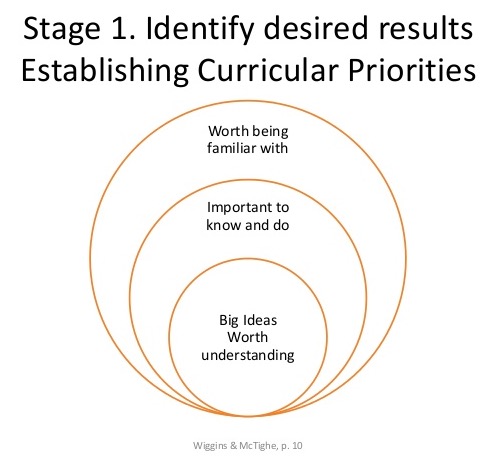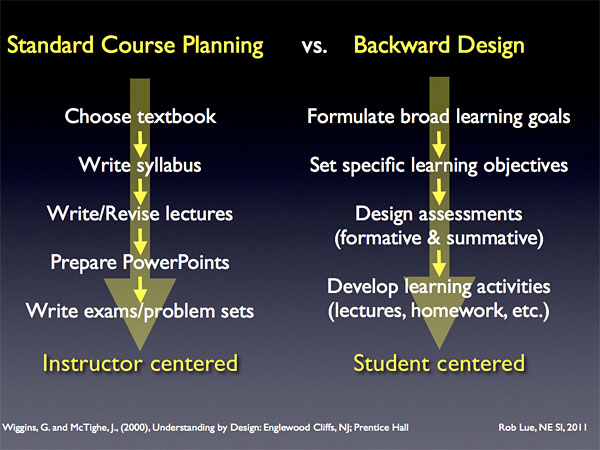Table Of Content

Backward Design can be summarized as a process or model for designing instructional materials where the instructor or instructional designer focuses on the desired end results (i.e., the outcome) of a class or course instruction. The designer then identifies what types of evidence are sufficient proof of the desired end result. The designer works “backwards” from that end goal and intentionally plans and develops supporting instruction and learning experiences around the desired outcomes and evidence[1].
Center for the Advancement of Teaching Excellence
Another foundational theory supporting Backward Design is Bloom's Taxonomy, developed by educational psychologist Benjamin Bloom and his colleagues in 1956. This framework categorizes learning objectives into a hierarchy of complexity, ranging from basic knowledge recall to higher-order skills like analysis and creation. Today, Backward Design is not just a trendy term but a key part of curriculum planning in many educational settings. You'll find its principles being applied in lesson plans, educational software, and teacher training programs. Coherent learning experiences & teaching that evoke and develop the desired understandings, promote interest and make excellent performance more likely. Before applying the backward design model, understanding the 7 principles and the big picture will support effective planning with clearly defined goals, aligned assessment and coherent lessons.
Contents
A week-long instructional design approach to teach postoperative pain management knowledge among Afghan ... - Journal of Global Health Reports
A week-long instructional design approach to teach postoperative pain management knowledge among Afghan ....
Posted: Fri, 12 Jun 2020 07:00:00 GMT [source]
Crafting realistic learning outcomes requires some understanding of students’ prior knowledge and skills in your subject. Looking ahead to step two of backward design, you will need to identify evidence that an intended learning outcome has been obtained. If a learning outcome is not measurable, then we will not be able to know whether or not our course successfully achieved its goals.
The Three Steps of Backward Design Are:
The “backward design” model exemplified here is developed in considerable detail by Grant Wiggins and Jay McTighe in their book Understanding By Design. While most of the examples in that book come from K-12 education, their method can be adapted to university education. As educational paradigms continue to evolve, frameworks like Backward Design will likely undergo revisions and adaptations. Current trends in educational technology, personalized learning, and inclusive education all offer exciting avenues for integrating and evolving the principles of Backward Design. For those new to Backward Design, diving in with an entire curriculum may feel overwhelming. Educational consultant and author Heidi Hayes Jacobs recommends starting with a single unit or even just one lesson.
The benefits & advantages of online learning
Activities can be passive such as listening to a lecture or watching a video, or active such as using manipulatives in math or holding small group discussions. In addition to the formative assessments that are used informally to guide instruction, summative assessments are used to gather evidence to determine what students have learned. Students should be able to justify their answers, apply their knowledge to other situations, and even teach others if they have truly mastered a concept. Planning starts with defining the learning goal and identifying the central question for the lesson. The second step establishes a definable target, an objective that you can measure.
Students know right from the start what they're aiming for, which helps keep them motivated and on track. They can ask, "What's the most important thing my students should learn from this lesson?" By concentrating on the key stuff, they make sure that the class time is well-spent and effective. A unit or sequence of lessons anchored in credible and vital evidence of the desired understandings.
This Drake Institute program offers guidance and compensation to full-time (.75 FTE) faculty at Ohio State for time spent researching evidence-based teaching practices and redesigning their courses around those teaching practices. Some of these might turn out to be not just fun to teach, but also solid in terms of equipping students with knowledge and skills that will last. And I got to drool over Matt Dillon in the movie’s opening scene again and again and again. One criticism of this approach is that is appears to promote “teaching to the test”. Yet despite the negative connotation that comes along with that phrase, arguable teaching to the test is exactly what the role of the instructor should be. But if a known final test or assessment is required, then backward design can be a useful way to prepare learners to perform well on the final assessment.
FAQs About Backwards Lesson Planning
This will also give students the chance to practice and apply skills in a variety of contexts, incorporate feedback, and get the practice they need to meet upcoming challenges in the course. For these same reasons, your assessment methods will ideally incorporate various degrees of difficulty or skill integration over the semester. Your completed Course Plan should lay out, in brief, the weekly assessments, course content, and teaching strategies and activities that align to the learning outcomes you create in Step 2 below. At this stage it is important to consider a wide range of assessment methods in order to ensure that students are being assess over the goals the instructor wants students to attain. Sometimes, the assessments do not match the learning goals, and it becomes a frustrating experience for students and instructors. Use the list below to help brainstorm assessment methods for the learning goals of the course.
Backward design lesson planning – What is it & why you should use it
Pursuant to the Backward Design model, desired results of instruction might be based upon national, state and local standards. This model prioritizes knowledge and focuses on what is most important for students to understand and achieve. Arguably, if design begins with the end in mind, instruction is more likely to clearly focus on the identified desired results[3]. Your learning outcomes should be achievable for the students in your class and achievable in the time allotted to your subject.
Imagine planning a road trip by first thinking about the destination, and then figuring out all the best stops and routes along the way. Well, there's a good chance the person teaching you used Backward Design to plan that awesome learning experience. We recognise the Ongoing Custodians of the lands and waterways where we work and live. We pay respect to Elders past and present as ongoing teachers of knowledge, songlines and stories.

These planned assessments must evaluate whether or not our students mastered the content. Only once the assessments have been planned, can we truly plan the most effective instructional activities. The Understanding by Design (UbD) framework promotes backward design to plan lessons that are aligned with standards and assessments and provide authentic activities that promote transfer of learning. The first step of backward design is to clearly identify the goal of a learning segment through alignment with the standard. The second step is to develop assessments that are aligned to the learning goal and provide opportunities for teachers to collect data about transfer of knowledge. Assessments may be a combination of formative assessments and summative assessments.
The traditional “frontloading” approach begins with the aims, goals, and objectives as a basis for writing of the curriculum, then developing learning activities and assessments (formative and summative) to assess the curriculum. With the backward design, the teacher or curriculum committee either develops the assessments or relies on evidence from commercial assessments or released items from state tests as a beginning point. Backward design arose in tandem with the concept of learning standards, and it is widely viewed as a practical process for using standards to guide the development of a course, unit, or other learning experience. Like backward designs, learning standards are a way to promote greater consistency and commonality in what gets taught to students from state to state, school to school, grade to grade, and teacher to teacher. Once the assessments are aligned to the intended learning outcomes, the job of in-class instruction becomes much clearer. Instead of asking before each class session, “what am I going to cover today,” in-class time can be devoted to helping students actually achieve the desired learning outcomes – and ultimately succeed on the various assessments.

Once you've determined what your students need to know, the next step is to figure out how to assess whether they have learned what they are supposed to learn. In addition, the teacher needs to decide how the evidence will be collected in a fair and consistent way that evaluates transfer of this knowledge. For many teachers, planning the assessments before planning the lessons seems counterintuitive, but it is the best way to focus instruction on what students really need to know. Backward Design allows for a more accurate and meaningful assessment of student learning. Experts like Dylan Wiliam have pointed out that because assessments are aligned with learning objectives from the get-go, they are more likely to be valid measures of student understanding and skill.
Click on each step for further details, key considerations, and guiding questions to walk you through backward designing your Course Plan. Wiggins and McTighe and other scholars have presented several arguments in favor of a backward design process. Okay, so we’ve looked very closely at one small unit for a middle school science class.
If your ILO states that students will be able to describe some phenomenon, don’t use a true/false or multiple-choice question to measure their attainment of this outcome. How you evaluate and grade an assessment should also track with your intended learning outcomes. A well-designed rubric can help you align your assessments to your intended learning outcomes. This last example provides intended learning outcomes for a subject focused more on soft skills, where measuring student ability objectively is significantly more nuanced and difficult.
No comments:
Post a Comment